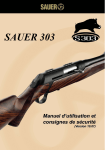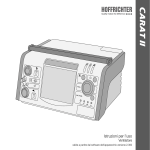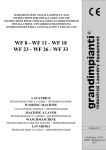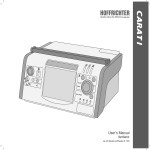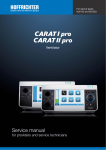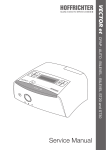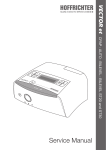Download Service Manual - Hoffrichter GmbH
Transcript
CARAT I and CARAT II Service Manual Ventilator valid for devices of the types 9LV102 and 9LV202 Table of Contents 1 Symbols in this Service Manual........................................................................................4 2 Safety Instructions...........................................................................................................4 3 3.1 3.2 3.3 Preparing the Device when Changing Patient..................................................................5 Reprocessing Procedure 1................................................................................................5 Reprocessing Procedure 2................................................................................................5 Reprocessing Procedure 3................................................................................................6 4 4.1 4.2 4.3 4.4 4.5 Block Diagrams................................................................................................................6 Block Diagram – Pneumatic (CARAT I)...............................................................................6 Block Diagram – Pneumatic (CARAT II)..............................................................................7 Block Diagram – Complete Machine..................................................................................7 Block Diagram – Controller Board......................................................................................8 Block Diagram – Power Management Circuit Board...........................................................8 5 5.1 5.1.1 5.1.2 5.1.3 5.2 5.3 5.4 5.5 5.5.1 5.5.2 5.5.3 5.5.4 5.6 5.7 5.8 5.9 Assemblies.......................................................................................................................9 Control Circuit Board.........................................................................................................9 Operating Section..............................................................................................................9 Control Section...............................................................................................................10 RS232 Circuit Board........................................................................................................10 Power Management Circuit Board...................................................................................11 Internal Battery................................................................................................................11 Fan Box..........................................................................................................................11 Valve Manifold.................................................................................................................11 Valve Base......................................................................................................................11 Sensor Manifold..............................................................................................................11 Flow Sensors..................................................................................................................11 Tube Connection.............................................................................................................12 Oxygen Manifold.............................................................................................................12 Filter Cartridge.................................................................................................................12 Power Supply..................................................................................................................12 Handle Mechanism..........................................................................................................12 6 Tools, Metering Devices.................................................................................................13 7 Opening the Machine.....................................................................................................13 8 8.1 8.2 8.3 8.4 8.5 8.6 8.7 8.8 8.9 8.10 8.11 8.12 8.13 8.14 8.15 Maintenance Hardware .................................................................................................14 Cleaning and Disinfection................................................................................................14 Filter Cartridge.................................................................................................................14 Check all Tubes...............................................................................................................14 Check the Cable and Connections...................................................................................14 Check Attachment of Printed Circuit Boards....................................................................15 Check Air Outlet..............................................................................................................15 Check the Display and Contrast.......................................................................................15 Button Functional Check.................................................................................................15 Calibration.......................................................................................................................15 Carry out Battery Test......................................................................................................18 Closing the Machine........................................................................................................18 Maintenance and Replacement Kits ................................................................................19 Check the Alarms............................................................................................................20 Data Backup...................................................................................................................20 Standard Values the Factory Setting................................................................................20 -2- 9 9.1 9.2 9.3 9.4 Safety-Related Check and Maintenance........................................................................22 Maintenance....................................................................................................................22 Recommended Maintenance Schedule............................................................................22 Safety-Related Check......................................................................................................23 Check the Electrical Safety of the External Power Supply.................................................23 10 10.1 10.2 10.3 10.4 10.5 10.6 10.7 10.8 10.9 10.10 10.11 10.12 10.13 Exploded Views..............................................................................................................24 Exploded View C – Inner Casing CARAT I........................................................................24 Exploded View C – Inner Casing CARAT II.......................................................................25 Exploded View C – Inner Casing CARAT II.......................................................................26 Exploded View A – Top Cover CARAT I............................................................................27 Exploded View A – Top Cover CARAT II ..........................................................................28 Exploded View E – Sensor Manifold CARAT I...................................................................29 Exploded View E – Sensor Manifold CARAT II..................................................................30 Exploded View B – Lower Cover CARAT (rear view).........................................................31 Exploded View B – Lower Cover CARAT (front view)........................................................32 Exploded View – Assembling CARAT I.............................................................................33 Exploded View – Assembling CARAT I.............................................................................34 Exploded View – Assembling CARAT II............................................................................35 Exploded View – Assembling CARAT II............................................................................36 11 Spare Parts List..............................................................................................................37 12 12.1 12.2 12.3 12.4 Disposal.........................................................................................................................39 Device.............................................................................................................................39 Packaging.......................................................................................................................39 Batteries..........................................................................................................................39 Oxygen sensor................................................................................................................39 13 13.1 13.2 13.3 Shipping Instructions for Contaminated Medical Technology........................................40 Pick-Up...........................................................................................................................40 Packaging for Shipping....................................................................................................40 Shipping..........................................................................................................................40 -3- 1 Symbols in this Service Manual In this Service Manual, the most important notes for users are indicated by symbols. Please make sure to follow these hints in order to avoid personal injury or property damage. Furthermore, all local accident prevention and general safety rules applicable to the intended use should be followed. This symbol marks a general safety precaution. Please follow these hints in order to avoid accidents and personal injury or property damage. This symbol denotes hazardous situations that lead to serious injuries or death. This symbol denotes hazardous situations that may lead to serious injuries or death. This symbol denotes information, tips and instructions for the efficient, error-free use of the device. 2 Safety Instructions •• Before you start with the maintenance, fully read and understand the contents of this Service Manual. •• There is a danger of short-circuiting of the capacitors and battery, even when no electrical power is applied to the machine. If the main switch is switched off and the power supply is connected, the internal battery is charged, electrical power is still applied to the machine! •• Repair and maintenance tasks may only be carried out by suitably qualified, authorized and competent personal. •• Oxygen sensors contain a caustic liquid. Avoid skin or eye contact if there is a sensor leak! •• For oxygen sensors no adjustment or repair work is required. •• For hygienic reasons, it is recommended to wear disposable gloves when you carry out a task on the machine. Before the next tasks, please wipe the machine with a commercial disinfecting solution. •• Special hygienic measures are necessary when a maintenance or repair task is carried out on a machine contaminated by MRSA (Methicillin Resistant Staphylococcus Aureus). In all circumstances, protective clothing must be worn, such as gloves, lab coat and face mask. -4- 3 Preparing the Device when Changing Patient Before using the ventilator on a different patient, clean and disinfect it to such an extent that it is free from any human pathogens. Please ensure that all tools used, such as measuring instruments and test lung, are free from human pathogens. If MRSA contamination is suspected, the device must be packaged, with the appropriate labeling, and disinfected accordingly. If the accessories (e.g., tube system, mask, fi lter, humidifier, etc.) are intended for repeated use, the manufacturer's provisions must be followed. The reprocessing of the device acc. to procedure 1 and 2 must be documented. 3.1 Reprocessing Procedure 1 The following measures may only be carried out by companies with a QM system and appropriately qualified, authorized and experienced specialist personnel. To reprocess the device, carry out the following steps: •• Properly dispose of the carrying case and, if necessary, the functional bag, as well as all accessory components that carry respiratory gas. •• Dismantle the device’s sensor block. The sensor block’s plastic parts are autoclaved. The sensors must not come into contact with cleaning fluids. A spray disinfection, e.g., using Mikrozid® Liquid, is possible. The sensors must be completely dry before replacing them in the sensor block. •• Use the maintenance kit 1. •• Disinfect all the parts of the housing and the connections with a suitable agent, e.g., Mikrozid® Liquid. •• Dispose of the filter cassette and replace it with a new one. •• Reassemble the device. •• After reprocessing, carry out a safety-related test according to the User’s Manual. •• Until the device is used again, store it safe from contamination with human pathogens. 3.2 Reprocessing Procedure 2 The following measures may only be carried out by companies with a QM system and appropriately qualified, authorized and experienced specialist personnel. The hygienic reprocessing of the devices during a patient change can be carried out in accordance with the validated KR 1000 procedure. The type and scale of the reprocessing are described in detail in the “Instructions for validated ventilation technology”. The number of reprocessing cycles for the device is limited to 10. After reprocessing, carry out a safety-related test according to the User’s Manual. -5- 3.3 Reprocessing Procedure 3 Procedure 3 can only be applied if the device was used with a bacteria filter, both at the inspiration port and at the expiration port, and the bacteria filter was changed daily, or according to the manufacturer’s instructions. This is the only way to ensure that the device is free of human pathogens. To reprocess the device, carry out the following steps: •• Change the bacteria filter. •• Disinfect all the parts of the housing and the connections with a suitable agent, e.g., Mikrozid® Liquid. •• Change the coarse filter and the fine filter and disinfect the surface of the filter cassette. You can also replace the entire filter cassette with a new one. 4 Block Diagrams 4.1 Block Diagram – Pneumatic (CARAT I) Figure 1:Block Diagram – Pneumatic CARAT I -6- 4.2 Block Diagram – Pneumatic (CARAT II) Figure 2:Block Diagram – Pneumatic CARAT II 4.3 Block Diagram – Complete Machine 100 ... 250 V AC (-20%/+10%) Figure 3:Block Diagram - Complete Machine -7- 4.4 Block Diagram – Controller Board Figure 4:Block Diagram – Controller Board 4.5 Block Diagram – Power Management Circuit Board Figure 5:Block Diagram – Power Management Circuit Board -8- 5 Assemblies 5.1 Control Circuit Board The control circuit board facilitates the operation and control of the artificial respiratory machine. The machine is divided into two main function groups, the operating section and the control section. 5.1.1 Operating Section Functions: 1. Selection of the respiratory mode and display by the Light Emitting Diode (LED) 2. Input of the respiratory parameters using the Multi-Function Knob (MFK) and display in the Liquid Crystal Display (LCD) 3. Start the respiratory mode 4. Saving the respiratory parameters set, and the applicable alarms 5. Display of alarms in the display and by the LED 6. Real-time clock 7. Communication through the external RS232 interface, remote alarm 8. Communication by the controller through the serial interface to 1.) The selection of the respiratory mode is made by pressing the esc | mode button. The actual respiratory mode is displayed by the applicable continuous lights of the LED, the new selected mode blinks until confirmation is made by pressing the MFK. to 2.) After selection of the respiratory mode, the applicable respiratory and alarm parameters are shown on the display. The choice and setting of the parameters is made through the MFK (selection of the parameters is by turning, acceptance by pressing the knob; Setting of the parameters by turning and acceptance by pressing the knob. Inputs made, but not yet confirmed, can be cancelled by pressing the esc | mode button). to 3.) Respiration is started by actuation of the ON/OFF button. To stop the respiration, the ON/OFF button must be actuated once for a period of 3 s. It is shown, as additional information, as a message on the display. to 4.) The parameter set, as well as the arising alarms set during the respiration, are saved in two serial EEPROMs (size 2 x 128 kByte). to 5.) An actual active alarm is signaled by the alarm LED (red - top row left) as well as by an acoustic signal. The alarm signal can be muted for a maximum period of 2 minutes by actuation of the alarm button. The optical alarm remains until the discontinuation of the cause of the alarm. If an alarm occurs during respiration, and the cause of the alarm disappears before the alarm can be switched to mute, the optical alarm display remains until actuation by pressing the control button. -9- to 6.) The real-time clock is, foremost, to indicate the time for an occurrence of an alarm. Furthermore, the operator date and time is shown on the display. to 7.) The communication with the external peripherals (e.g. Windows computer) is through an isolated RS232 interface. The programming (software update) of the controller can also be done through this interface. to 8.) The communication with the controller is through another serial interface. 5.1.2 Control Section Functions: 1. C ontrol the turbine and the valves, to implement the set respiration modes with the appertaining parameters 2. Detection of alarm situations 3. Communication with the operation controller through a serial interface 4. Communication with the power management controller through a serial interface to 1.) The calculation for the nominal values for the motor control is made from the respiratory mode set and the appertaining parameters. The nominal value output is through a DAC on the motor control. The nominal values (analog measured values – pressure or flow) are read and evaluated from the controller. Furthermore, the switching on/off of the turbine is through the controller, as well as the control of the (electromagnetic) proportion valve. This valve controls the pneumatic expiration valve in the line circuit (expiration valve closed inspiration; expiration valve open expiration). to 2.) The condition of the alarm is checked through the controller, and in the case of an alarm the emission of an acoustic signal. The volume of this signal is adjustable. to 3.) The communication with the operation controller is through a serial interface. to 4.) The communication with the power management controller is through a second serial interface. 5.1.3 RS232 Circuit Board The communication with the external peripherals (Windows computer software CaratControl) is through the RS232 circuit board. In addition, with the help of this circuit board, a remote alarm box or a call nurse can be connected to the machine. - 10 - 5.2 Power Management Circuit Board Functions: 1. Current measurement and allocation of the available current according to the priority 2. Display of the operating condition 3. Determining the capacitance and state of charge of the internal battery 4. Charge the internal battery 5. Transmission of the “battery-data” to the processor to be shown on the display 5.3 Internal Battery The internal battery comprises of two Lithium-Ion batteries (Pana CRG 18650 CF) that are connected to a 28.8 V, 2.25 Ah manifold. 5.4 Fan Box The fan is installed in the fan box and the fan comprises of a Direct Current (DC) motor from the firm Maxon (50 W, with high uniform speed) and a fan impeller (D = 49 mm). 5.5 Valve Manifold The valve manifold comprises of the following components as described and serves as the control and transfer, as the case may be, between inspiration and expiration. The valve manifold is directly connected (by a seal) with the fan box. The oxygen feed is through the valve manifold into the inspiration sector. 5.5.1 Valve Base The valve base comprises of several control ducts that are shut with special seals, a non-return valve in the inspiration sector and a proportion valve. The valve base is bolted to the sensor manifold. The sealing is by O-rings. There is a connection for the oxygen tube on the valve base. 5.5.2 Sensor Manifold The pneumatic control for the inspiration and the expiration is done through the sensor manifold. This function is done by two diaphragms (one each in the inspiration and expiration sector). The diaphragms are inserted in the manifold and subsequently the valve cap installed and closed by turning the bayonet connection. The sealing is by an O-ring. 5.5.3 Flow Sensors For the measurement of the flow, airflow sensors AWM720P1 from the firm Honeywell are used. The sensors are directly in the inspiration and expiration sector (with seals between the manifold and tube connection). There is only one sensor installed (inspiration sector) in the CARAT I machine. - 11 - 5.5.4 Tube Connection The tube connection completes the manifold. It comprises of the connection for the inspiration tube (22M), the connection for the expiration tube (22F), the connection for the pressure tube (Ø 3.5 mm) and the connection for the control tube (subminiature coupling with bayonet connection [for oneline circuit]). The Printed Circuit Board (PCB), for the electrical connector of the oxygen measurement cell, is also mounted on the tube connection. 5.6 Oxygen Manifold The oxygen manifold comprises of a 3/2-way valve and a synthetic manifold. This manifold makes sure that oxygen only goes into the inspiration sector during inspiration. If there is a feed of oxygen when respiration is switched off, this is vented to atmosphere through an exhaust port, for safety reasons. According to the flow, this emission is accompanied by an emission noise. This is not a malfunction, but a safety device. The initiation of oxygen into the machine is through a quick-release coupling. 5.7 Filter Cartridge The filter cartridge accommodates both of the filter pads (coarse filter [black] and fine filter [white]). 5.8 Power Supply A switching power supply, with a wide-range power input of 100 - 250 V AC (-20 %/+10 %) / 50 Hz - 60 Hz and an output voltage of 24 V DC / 5 A, is used. 5.9 Handle Mechanism The handle mechanism comprises of an anodized aluminium handle that serves as a means of carrying. Furthermore, the handle mechanism has 2 handle levers (right and left), 2 covers (right and left) as well as 2 catches. - 12 - 6 Tools, Metering Devices To carry out maintenance, the tools and equipment are required as follows: •• Screwdrivers of various sizes (special cross-head PH1 x 200) •• Compressed air supply, or stationary compressed air connection •• Soft brush and vacuum cleaner •• Soft underlay •• Disposable gloves •• Airflow Pressure Meter (APM) (0 - 100 hPa, e.g. HOFFRICHTER APM Art. no.: 00004832) •• Blanking caps, with T-piece and silicon tubes (Art. no.: 00004831) •• Flow meter (0 - 200 l/min e.g. HOFFRICHTER APM Part No.: 00004832) •• Therapy tube, with pressure metering tube (Part No.: 00007116) •• CARAT power supply (Art. no.: 00004510) 24 V DC / 5 A, or a 230 V AC power supply connection •• PC, Windows 95 - XP, Vista, 128 MB RAM, high colour capable graphic card •• PC cable (RS232 Art. no.: 00007110) •• HOFFRICHTER software CaratControl •• Spray disinfectant (e.g. Mikrozid AF Liqide) •• Replacement or maintenance kit, according to the maintenance cycle (see chapters 8.12 and 8.12) •• Adapter and machine to check the electrical safety (e.g. SECUTEST SIII) •• Machine and maintenance documentation 7 Opening the Machine 1. Main switch OFF, disconnect power supply. 2. Remove the filter cartridge and pull the MFK. 3. P ut the machine, with the upper side, on a soft underlay and use a long screwdriver (special cross-head PH1 x 200) and remove the two screws at the rear of the machine (above the type label). 4. Use a screwdriver and remove the other two attachment screws at the front, lower side of the machine (top cover). 5. T urn the machine over and lift off the top cover, place in a safe place and secure from falling and mechanical damage. 6. D isconnect the multipole connector for the main switch (top four plug contacts) and DC connection (lower four plug contacts) from the power management circuit board (tag if necessary). 7. Remove the tube for the initiation of oxygen from the sensor manifold. 8. L ift up the inner mounting and pull lightly forward so that the multipole connector of the oxygen valve can be disconnected from the power management circuit board. 9. Lift the inner mounting from the bottom cover. - 13 - 8 Maintenance Hardware 8.1 Cleaning and Disinfection 1. Use a brush and vacuum cleaner and carefully clean the bottom cover and inner mounting. 2. U se compressed air to clean inaccessible areas and subsequently use a vacuum cleaner to gather loose particles. 3. U se a cloth, moist with normal concentrated soap solution, to remove stubborn contamination on the inside and outside of the top and bottom covers. 4. U se surface disinfection and spray for components that duct the air. For this purpose, coat the following components with 2-3 squirts: –– Air inlet and filter insert (inside of the bottom cover) –– Intake port (rear of the inner mounting) –– Air outlet (rear of the valve manifold) –– Tube connections the respiration tubes (inside) 8.2 Filter Cartridge Replace the filter pads (coarse filter [black] and fine filter [white]). Remove the control circuit board to do points which described in the chapters 8.3 and 8.4. 8.3 Check all Tubes Check every silicon tube used in the machine for signs of mechanical damage, ageing and for correct seating and, if necessary replace: •• Oxygen connection tube in the bottom cover •• Connecting tubes in the manifold between the valve base and tube connection •• Pressure metering tubes on the pressure sensors 8.4 Check the Cable and Connections Check every connection and supply cable for signs of damage and correct seating and, if necessary to correct or replace: •• RS232 cable •• DC cable •• Battery cable •• Resistance cable •• Valve connecting cable •• Flow sensor cable •• O2 sensor cable •• Motor cable •• Display cable - 14 - 8.5 Check Attachment of Printed Circuit Boards The controller circuit board is attached to the inner mounting. Subsequently check the attachment of all PCBs: •• Controller circuit board: 2 screws •• RS232 circuit board: 2 screws •• Power management circuit board: 3 screws •• O2 metering cell circuit board: 1 screw 8.6 Check Air Outlet Check the air outlet (on the rear of the valve manifold) for correct seating, and attention must be paid to make sure that the synthetic hopper is inserted to the shoulder in the valve base, if necessary correct the seating. After completion of the task, position the inner mounting in the bottom cover and connect all of the electrical and pneumatic connections. During the following tasks, there is a voltage supply to the open machine. The task, therefore, must only be carried out by authorized, qualified and competent personal. If the service task is done in the home, the patient must be advised of the dangers. The following checks are carried out with the machine switched on. 8.7 Check the Display and Contrast Do a check, to make sure that all of the characters are completely and correctly displayed. The contrast can be adjusted with the assistance of the potentiometer, on the right adjacent to the display. 8.8 Button Functional Check Operate the alarm, ON/OFF, esc | mode buttons and the MFK to make sure that they function correctly. 8.9 Calibration A calibration must be carried out in the scope of the annual maintenance, or after a repair of relevant assemblies. 1. Pressure Sensor Calibration 1.1.Install blanking caps on the inspiration connection. Connect the metering tube of one leg of the T-piece with the pressure metering connection of the CARAT and the second with the pressure inlet of the APM. 1.2.Press the MFK for an extended period, to get to the “Service” screen. 1.3.There, make the selection menu item “Pressure Sensor Calibration”, enter the appropriate PIN code and confirm. 1.4.The calibration is carried out at 0, 5, 10, 20 and 40 hPa. - 15 - 1.5.The value shown on the meter is set to the calibration value by turning the MFK and accepted by pressing the esc | mode button. 1.6.The value must be set to an accuracy of ± 0.05 hPa. 1.7.Abortion is by pressing the MFK for a period of more than 3 seconds. 1.8.After the calibration, press the MFK momentarily to return to the standard screen. Figure 6: Measurement setup pressure sensor calibration CARAT I and CARAT II 2. Flow Sensor Calibration 2.1.For the CARAT I, attach the respiration tube, with pressure metering tube, to the inspiration connection and connect the pressure metering tube. The measurement of the flow is taken at the open side of the tube. 2.2.For the CARAT II, attach the flow meter to the inspiration connection or expiration connection. The open connection of the flow meter must be connected to the open section of the CARAT II by the respiration tube with pressure metering tube. Thereby, the metering tube must be connected with the pressure metering connection of the device. 2.3.In the Service display, make the selection menu item “Flow Sensor Calibration”, enter the appropriate PIN and confirm. 2.4.The calibration is carried out at 0, 10, 20, 40, 60, 80, 100, 120 and 160 l/min. 2.5.The measured value shown on the flow meter is to be set to the calibration value by turning the MFK and accepted by pressing the esc | mode button. 2.6.The value must be set to an accuracy of ± 1.5 %. 2.7.To abort the calibration, press the MFK for a period of more than 3 seconds. 2.8.After the calibration, press the MFK momentarily to return to the standard screen. - 16 - Figure 7:Measurement setup flow sensor calibration CARAT I Figure 8:Measurement setup flow sensor calibration CARAT II 3. Leak Test 3.1.For the CARAT II, connect the inspiration and expiration connections with the respiration tube and the metering tube with the pressure metering connection of the device. 3.2.For the CARAT I, connect the respiration tube with pressure metering tube to the inspiration connection and the metering tube with the pressure metering connection of the device. Install a blanking cap in the open side of the respiration tube. 3.3.On the third screen, select the menu item “Leak Test”, enter the PIN code and confirm. 3.4.The machine now goes through the complete pressure range and identifies leaks autonomously. These are shown on the display. The maximum deviation must not exceed 5 l/min at flow sensor 1, and must not exceed 1 l/min at flow sensor 2. 3.5.During the leak test, the complete pressure range is tested up to the maximum value. The switching threshold is between 55 hPa and 60 hPa. If there are deviations, adjustments can be made on the pressure switch. - 17 - 8.10 Carry out Battery Test During the test of the internal battery, the machine remains connected to the mains, is switched on at the main switch, and must not be disconnected from the mains during the test. No line circuit or other accessories must be used during the test procedure. To start the test procedure, press and hold the MFK until the service screen appears. Select the menu item “Battery Test”, and use the MFK to confirm. After entering the PIN code, the battery test is then carried out. It consists of three phases: 1. Phase: Battery being charged (max. 3 Hrs. depending on the charge condition of the battery) 2. Phase: Battery now being discharged with constant charge (3 - 3.5 Hrs.) 3. Phase: Battery being charged (3.5 Hrs.) After completion of the 3. Phase, the capacitance of the battery is shown on the display, instead of the battery icon. If the capacitance is > 80 %, the test was successful. If the capacitance is less, and an additional display “Error” shows on the display, the battery must be replaced with a new one. Always replace both of the Lithium Ion batteries. The test takes a maximum of 10 Hrs. The internal battery must be replaced after every 500 charge and discharge cycles, or every two years. The test intervals are specified in the recommended maintenance schedule (chapter 9.2). 8.11 Closing the Machine After the maintenance and calibration is completed, the machine must again be closed. 1. Remove all components used for the calibration (blanking caps, meters, respiratory tube etc.). 2. C heck to make sure that the inner mounting is in the correct position in relation to the bottom cover. 3. T he closing position is attained when both of the front corners of the inner mounting are located in the corners of the bottom cover. 4. C heck to make sure that no cables or tubes impede, or complicate the installation of the top cover, and that none will be trapped or squeezed. 5. From the front, guide the top cover over the tube connections and into the installation position. 6. Attach the top and bottom covers together at the front and rear. 7. Insert the filter cartridge (with new coarse and fine filter) in the filter tray. 8. Attach the MFK. - 18 - 8.12 Maintenance and Replacement Kits Use the following kits for the various replacement and maintenance cycles (chapter 9.2): Diaphragm Replacement Kit (Art. no.: 00004983) Quantity 1 1 1 Nomenclature Valve diaphragm O-Ring Cable tie Maintenance Kit 1 (Art. no.: 00004984) Anzahl / Length 2 2 1 1 1 0.5 m 0.35 m Nomenclature Valve diaphragm O-Ring Coarse filter Fine filter Cable tie Silicon tube 4 x 2 mm Silicon tube 2 x 1.5 mm Maintenance Kit 3 (Art. no.: 00004987) Anzahl / Length 2 2 1 1 2 0.5 m 0.35 m 2 Nomenclature Valve diaphragm O-Ring Coarse filter Fine filter Cable tie Silicon tube 4 x 2 mm Silicon tube 2 x 1.5 mm Lithium-Ion battery (Pana CRG 18650 CF) Maintenance Kit 5 (Art. No.: 00004986) Anzahl / Length 2 2 1 1 6 0.5 m 0.35 m 1 Nomenclature Valve diaphragm O-Ring Coarse filter Fine filter Cable tie Silicon tube 4 x 2 mm Silicon tube 2 x 1.5 mm Fan box (complete) - 19 - 8.13 Check the Alarms You must adhere to the procedure given in chapter “Functional Check” of the User's Manual. 8.14 Data Backup If it is proposed to change the set parameters during a SRC or maintenance, the contents of the device memory must be read and saved. If necessary, the data is to be analyzed. No maintenance is necessary to the PC software. 8.15 Standard Values the Factory Setting Parameter values in accordance with the factory setting (through a PC or direct on the device) General Parameters Mode Display I:E Display Pressure Units Display Screen Safety Lock Safety Lock (Machine) Volume Pressure Deviation Max. Inspiration time Leakage Max. Oxygen Min. Oxygen PIN code Device Language PCV I:E hPa STD Manual OFF 50 % 3.0 hPa 4s OFF OFF OFF 1302 ENG Parameter PCV IPAP PEEP Frequency I:E Chute Inspiration trigger Min. Volume Additional pressure Max. Volume Min. Volume Max. Frequency 20.0 hPa 5.0 hPa 12 bpm 1 : 1.5 3 OFF OFF 5.0 hPa (not active, Min. volume is set to OFF) 1.00 l 0.20 l 30 bpm - 20 - Parameter PSV PS PEEP Frequency Apnoea limit Chute Inspiration trigger Expiration trigger Min. Volume Additional pressure Max. Volume Min. Volume Max. Frequency 20.0 hPa 5.0 hPa 12 bpm AUTO 3 3 30 % OFF 5.0 hPa (not active, Min. volume is set to OFF) 1.00 l 0.20 l 30 bpm Parameter SIMV IPAP PS PEEP SIMV-Frequency Inspiration time Chute Inspiration trigger Expiration trigger Max. Volume Min. Volume Max. Frequency 20.0 hPa 20.0 hPa 5.0 hPa 12 bpm 2.0 s 3 3 30 % 1.00 l 0.20 l 30 bpm Parameter VCV Volume PEEP Frequency I:E Chute Inspiration trigger Max. Pressure Min. Pressure Max. Frequency 0.50 l 5. hPa 12 bpm 1 : 1.5 1 OFF 30.0 hPa 10.0 hPa 30 bpm Patients data Patients ID Patients surname Patients christian name Patients birthday Patients gender deleted deleted deleted deleted 2 (undefined) - 21 - 9 Safety-Related Check and Maintenance 9.1 Maintenance The respiratory machine must be serviced by an authorised specialist every 12 months. 9.2 Recommended Maintenance Schedule Operating Hours Required Maintenance Before and during storage: every 6 months Carry out battery test (see chapter 8.10) Weekly Clean the air filters (coarse filter) Before return to service Alarm test (leakage, power failure), Carry out battery test after 3 month storage (see chapter 8.10) Monthly, or earlier by heavy contamination Replace of the air filters (coarse and fine filter) Every 6 months without bacteria filter or by change of patient Replace the valve diaphragms (expiration) (diaphragm replacement kit) By change of patient Hygienic overhaul with KR1000 in accordance with the report V 1.2 of the disinfection of the home-care respiratory machine CARAT Every 12 months with bacteria filter Replace the valve diaphragms (Inspiration) Every 6 months without bacteria filter Safety Regulation Check (SRC) (diaphragm replacement kit) Every 12 months Maintenance (Maintenance Kit 1) Every 2 years Replace the internal battery of the machine (Maintenance Kit 3), Carry out battery test (see chapter 8.10) Every 15000 h or every 5 years or graphical display in CARATControl Replace the fan box (Maintenance-Kit 5), Carry out battery test (see chapter 8.10) Disinfect The disinfection after a change of patient and by a MRSA polluted machine, is carried out by the manufacturer, in accordance with report V 1.2 of the disinfection of the home-care respiratory machine CARAT The maintenance carried out must be documented. - 22 - 9.3 Safety-Related Check The safety-related check must be carried out at intervals of no more than 6 months. This consists of: •• A visual inspection of the machine (for external damage) •• A functional check (acc. to User's Manual) •• A visual inspection of the accessories, in accordance with the manufacturer’s instructions (respiratory tubes, oxygen sensor, etc.) The safety-related check carried out must be documented. 9.4 Check the Electrical Safety of the External Power Supply Tests The tests carried out by an equipment safety tester (e.g. SECUTEST SIII), which operates according to DIN EN 62353:2008. The leakage currents are always to calculate per direct measurement. The ventilation system should be test acc. to protection class II type BF applied part. The associated power supply with protection class I will be tested within the system. Defects in the power supply are detected by testing the entire system acc. to protection class II. Leakage current The leakage current is measured with a probe from the equipment security tester (e.g. SECUTEST SIII), at the RS232-housing (GND pin 5), at the alarm box connection, at the connection piece for pressure measurement and at the connection of the oxygen sensor. The test is passed if the limits of the leakage current are maintained acc. to DIN EN 62353-2008, table 2. - 23 - 10 Exploded Views 10.1 Exploded View C – Inner Casing CARAT I - 24 - 10.2 Exploded View C – Inner Casing CARAT II - 25 - 10.3 Exploded View C – Inner Casing CARAT II - 26 - 10.4 Exploded View A – Top Cover CARAT I - 27 - 10.5 Exploded View A – Top Cover CARAT II - 28 - 10.6 Exploded View E – Sensor Manifold CARAT I - 29 - 10.7 Exploded View E – Sensor Manifold CARAT II - 30 - 10.8 Exploded View B – Lower Cover CARAT (rear view) - 31 - 10.9 Exploded View B – Lower Cover CARAT (front view) - 32 - 10.10Exploded View – Assembling CARAT I - 33 - 10.11Exploded View – Assembling CARAT I - 34 - 10.12Exploded View – Assembling CARAT II - 35 - 10.13Exploded View – Assembling CARAT II - 36 - 11 Spare Parts List Pos. A A-I A-II A1 A2 A3 A4 A5 A6 A7 A8 A9 A10 Nomenclature Top Cover CARAT Top Cover CARAT I plus Top Cover CARAT II plus Cover Adjustment Knob CARAT MFK with Cover Spring Circlip Design A8 DIN7993 Intake Adjustment Knob, lower part CARAT Push button Protective Film Display CARAT Intake Adjustment Knob, upper part CARAT Protective Cap RS232, coated Label CARAT I, HOFFRICHTER Label CARAT II, HOFFRICHTER Order No. B B1 B2 B3 B4 B5 B6 B7 B8 B9 B10 B11 B12 B13 B14 B15 B16 B17 B18 B19 B20 B21 B22 Bottom Cover CARAT Cover Assembly Kit, right Cover Assembly Kit, left Housing with Aperture, upper part, drilled + painted CARAT Lower Housing Cover for Expiration Valve Assembly Kit Handle Lever, left Assembly Kit Handle Lever, right Torx Screw for Handle Wool Felt Assembly Kit Stop Plate for Handle Lever Impact Sleeve natural white M5 x 8.6 x 11 Oxygen Manifold Handle incl. Impact Sleeve and Screws Main Switch, assembled DC Cable, assembled Type Label Artificial Respiratory Machine O2 Coupling Protective Cap for Main Switch Foot, small 3/2-Way Valve with Screws + Socket Board Socket Boards 2-pin for 3/2-Way Valve Silicon Tube for Oxygen Manifold Foot, large C C1 C2 C3 C4 C5 C6 C7 C8 C9 C10 C11 C12 C13 Inner Mounting CARAT Air Outlet PCB Power Management Inner Mounting, upper part Inner Mounting, lower part, assembled Box CARAT, assembled Battery Pack, assembled (Li-Ion) Battery Retainer Pressure Switch PCB RS232 Cover RS232 PCB Controller RS232 and Controller Cable, assembled Display 00004645 00004646 00004956 42202446 22000049 22000050 00004961 00004962 42202460 00004958 00004957 43000097 00004954 42100447 00004953 00004201 00004102 41000086 32100027 42100426 00004273 32200068 45000019 42100425 42100441 00004336 00004505 16000015 00004124 00004329 00004328 00004103 00004318 - 37 - Pos. Nomenclature D Filter Housing CARAT D Filter Housing CARAT, complete E E1 E2 E3 E4 E5 E6 E7 E8 E9 E10 E11 E12 E13 E14 E15 E16 E17 E18 E19 E20 E21 Sensor Manifold CARAT Tube Connection CARAT I Tube Connection CARAT II PCB Oxygen Cover for O2 Metering Cell Coupling Control Connection Einsatz Tube Connection, chem. nickel-plated Valve Diaphragm Valve Cover (sensor manifold) Valve Base Proportion Valve + Socket Board Support O2 Metering Cell Seal Flow Sensor Spacer long, nickel-plated Flow Sensor Flow Sensor Cable CARAT I, assembled Flow Sensor Cable CARAT II, assembled Spacer short, nickel-plated Tie-Rod M3, nickel-plated Sensor Manifold for Replacement of Diaphragm Seal, Air Outlet Fan Box O-Ring 32 x 1 (sensor manifold) O-Ring 30.6 x 1 (sensor manifold) from SN: C05L0351 Silicon Tube 2 x 1.5 x 350 mm Diaphragm Replacement Kit Maintenance Kit 1 Maintenance Kit 3 Maintenance Kit 5 Order No. 00004323 41000089 42100423 42100463 00004272 23000023 00004121 00004101 42100424 44000030 44000039 45000002 00004983 00004984 00004987 00004986 12 Disposal Proper disposal saves natural resources and prevents harmful substances being released into the environment. 12.1 Device The ventilator must not be disposed of with the household waste. Please contact the manufacturer to find out how to dispose of the device properly. 12.2 Packaging The packaging is taken back by the distributor but it can alternatively be disposed of separately in the normal household waste. 12.3 Batteries Exchanged batteries must be recycled in accordance with battery regulations. Please contact the manufacturer to find out how to dispose of the batteries properly. 12.4 Oxygen sensor The oxygen sensor must not be disposed of with the household waste. Please contact the manufacturer to find out how to dispose of the oxygen sensor properly. - 39 - 13 Shipping Instructions for Contaminated Medical Technology The following shipping instructions apply to contaminated medical technology which is delivered to HOFFRICHTER GmbH for processing. 13.1 Pick-Up The dealer, medical technician or authorised personnel picks up the contaminated medical technology from the patient. A local surface disinfection of the equipment and accessories with microcide liquid spray (MRSA active) takes place followed by carefully placing the objects in bags with the use of disposable gloves, mask and disposable apron. The proper disposal of disposable materials is respected. 13.2 Packaging for Shipping The packaging of equipment/accessories in sterile welding foil followed by shrink wrap or packing in PVC or PE bags (tear resistant) and sealed by tape or tie wrap takes place at the dealer’s or in the service departments. Power cable, ventilation equipment, user`s manual and other accessories with minimal risk of infection must be properly disposed of. Hint: “CAUTION – CONTAMINATED EQUIPMENT” or “CAUTION – MRSA-CONTAMINATED EQUIPMENT’” must be visibly placed on the packaging. The packaging must be proper and robust and must not be contaminated. The box is conscientiously sealed with packing tape. 13.3 Shipping The delivery note must be on the outside of the equipment packaging. (Notice on delivery note: “CAUTION – CONTAMINATED EQUIPMENT” or “CAUTION – MRSA-CONTAMINATED EQUIPMENT’”). Shipping takes place by appropriate logistics companies. - 40 - HOFFRICHTER GmbH Mettenheimer Straße 12 / 14 19061 Schwerin Germany Phone:+49 385 39925 - 0 Fax: +49 385 39925 - 25 E-Mail:[email protected] www.hoffrichter.de CARAT FL-service-eng-070911-06









































